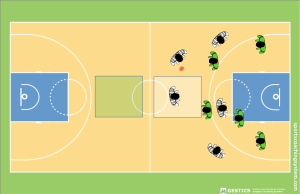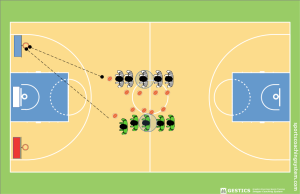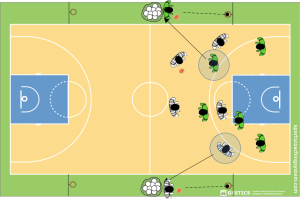HLA
AROUND SPORT – SIMPLY BASKET
- Brief description
- Context and needs
- Activities and rules
- Location, environment and equipment
- Method
- Side Activities
- Target
- Impact
Simply Basket is a team sport with great inclusive potential because the ball is handled with the hands and this gives great security to players. Each team plays with 5 players and at least one disabled player. Game changes are flying and unlimited and the disabled player can only be replaced by another disabled player (during the game there must always be a player with disabilities).
Simply basket is a sport that allows everyone to express their full potential. The ball is handled with the hands to give great security to players. The rules of inclusive sport allow all players to be part of a team
Simply basketball develops in 3 moments:
- Play match “The castle”
Rules:
Inside the castle (2/3 met x 2/3 met in the middle of the field made of 4 cones) there is a jolly player that must receive the ball before the basket (see picture). In the castle there is only the jolly, and can not enter other players. Thanks to this rule, when the disabled becomes the joker, is involved emotionally in the match. All players in turn can be the joker.

- Play exercise “coloured basket”
Rules:
Each athlete chooses a partner, non disabled or disabled child, creating many pairs in order to help each other (see picture) Disabled player wins 1 point every time he makes a basket of the color called. The player without disability wins 1 point every time he scores before the opponent. Players have more shots available to make the basket.

Conduct and score:
At the start the players run dribbling trying to make the basket of the color called. There are three manches. The team that scores the most points wins the manche and the team that scores 2 manches of 3 wins. If the player with disabilities needs to be involved in the game with education strategies, it is necessary to have an educator who supports the athlete.
- Play match “Simply Game”
Rules:
The match lasts 10 minutes.
Each team consists of 5 players, of which 1 player with disabilities (4+1). The player with disabilities will have to be involved in the game using educational strategies. Sometimes it isnecessary to have an educator who supports the athlete.

Conduct:
During the match, at the auditory or visual signal, both athletes leave the game and reach the path next to the field. Here they’ll have to run dribbling trying to make the basket If the athlete makes a basket, it will be counted in the final scores of the match. Every 2 minutes the signal is given to the player for a total of 5 moments during the match.
Outdoor or indoor playground.
Basketballs and basket with net (the net is important for the emotional aspect)
- Include in each team a maximum of 2 athletes with disabilities
- Obliquity: all athletes must experience the perception of psychophysical well-being of
motor activity. Each athlete must have the opportunity to train to the maximum of their
potential and live the moments of slowing down as wealth
For example: during the simply game the player can make a basket both in the game and when he is called in the play exercise on his own.
- Equity: create exercises where the final gratification is present for all. For example: the coloured basket allows each player to make the baskets on their own
- Tool: use the game in all its aspects as a main learning tool (G.M, G.E., G.S, G.M.)
- Create an extra workout only for non disabled children to lower the emotional commitment of the player and give more freedom during the match. This helps to have a greater predisposition to the inclusive game.
- Sharing the sporting and social goals of the inclusive path with staff, society and families
- Matches with other teams with a moment dedicated to the inclusive game to make other teams live
- Parties and sporting events where non disabled and disabled children collaborate and work together to realize the event
- Cultural conferences of education to inclusion
Males and females from 8 to 13 years
Exponential growth of:
- emotional intelligence (empathy)
- know how to manage the needs of the disabled player
- Mathurity (both of non disabled and disabled children)
- Happiness and satisfaction
Increased sensitivity in collaborative actions by athletes during the match
Lowering moments of aggression.
Fair Play.
PlayInc Key Aspects
Simply basket allows everyone to express their potential allowing an increase in technical-tactical, emotional-cognitive, motor and partner skills of the individual and the group.
Thanks to the rules are involved all participants always keeping high energy in the play and this determines the sense of belonging to the team. The coach can creatively manage the heterogeneous group with simple rules and strategies. The ratio between the number of disabled and no disabled people allows everyone to have successful experiences having fun.
Collateral activities promote and demonstrate that you can include child with disabilities with child without disabilities without having to change the rules of the game too much and guaranteeing to all a training, engaging and fun sport practice.
Contact the organisation
Contact

Name: Around Sport (AS)
Website: https://www.around-sport.it
Facebook: https://www.facebook.com/aroundsport.it
E-mail: internationalaffairs@aics.info
